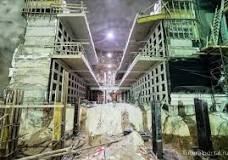Har Menuchot tunnels. (photo credit: KEHILLAT YERUSHALAYIM BURIAL SOCIETY)
Kehillat Yerushalayim is the biggest burial society in Jerusalem and carries out burials for more than half of all deaths in the capital.
Beneath Jerusalem, a labyrinth of tunnels stretching over one-and-a-half kilometers in length and cavernous in size has been excavated to accommodate the holy city’s ever increasing need to house its dead.
The massive project, expected to cost upwards of NIS 220 million, has been undertaken not by the state or its agencies, but by a Hevra Kadisha, or burial society, that became aware of the disadvantages of using more and more land for burial purposes and sought a solution to this problem.
Chananya Shachor, head of the Kehillat Yerushalayim burial society, explained that approximately 3,500 Jews die every year in Jerusalem and need to be buried in one of the capital’s three Jewish cemeteries: Har Hamenuhot Cemetery – where 90% of all Jerusalem’s dead are buried – the Mount of Olives and the Sanhedria Cemetery.
This excludes the large number of Israeli citizens who are not resident of Jerusalem, as well as Diaspora Jews that buy plots in the holy city for their burial.
Kehillat Yerushalayim is the biggest burial society in Jerusalem, carrying out burials for more than half of all deaths in the capital.
Shachor notes that using normal burials where individual graves are dug in the earth, one next to the other, allows for 3,200 graves per hectare of land – 10,000 sq.m.
Burial in multistory buildings above ground allows for more than 12 times as much – 40,000 graves per hectare – while burial in these new tunnels allows for a total of 51,000 graves per hectare, both below and above ground – 16 times as many as in a regular side-by-side cemetery.
And should the current project prove a success, Shachor says he could build new tunnels below the existing ones, almost doubling the number of graves.
Because of the large demand for burial space in Jerusalem and the lack of available land in general, Shachor embarked on an enterprise five years ago to investigate and eventually carry out a project for burials in underground tunnels beneath Jerusalem.
Speaking to The Jerusalem Post, Shachor noted that burials in niches dug into tunnels were done in antiquity by the Jewish people in the Land of Israel, and that several examples of such graves can be found in the country – such as in Beit She’arim, where the famous compiler of the Mishna, Rabbi Yehudah Hanasi, is buried.
After conducting feasibility studies and obtaining the requisite permits from the Jerusalem Municipality, excavation of the tunnels began at the end of 2015.
The new tunnels under Har Hamenuhot Cemetery are 16 meters in diameter and were dug 50 meters below the surface-level cemetery.
Mechanical diggers specifically designed for this project were built to dig the 23,000 niche graves that line the walls of the 1.6 km. of tunnel that have been dug into the hillside.
BY JEREMY SHARON









